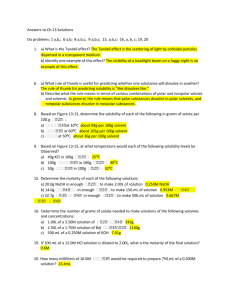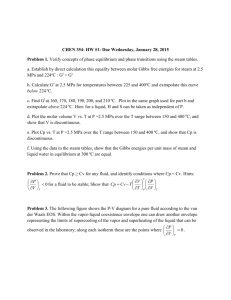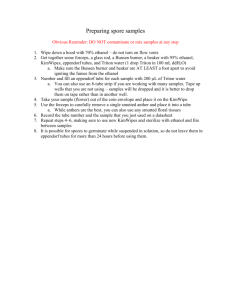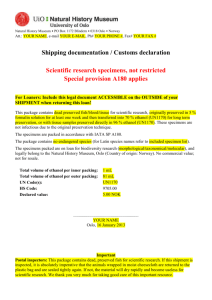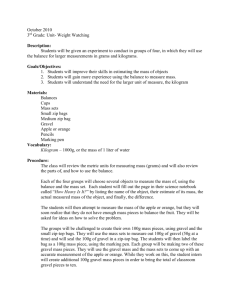KISII SOUTH SUB DISTRICT JOINT EVALUATION TEST 2014
advertisement
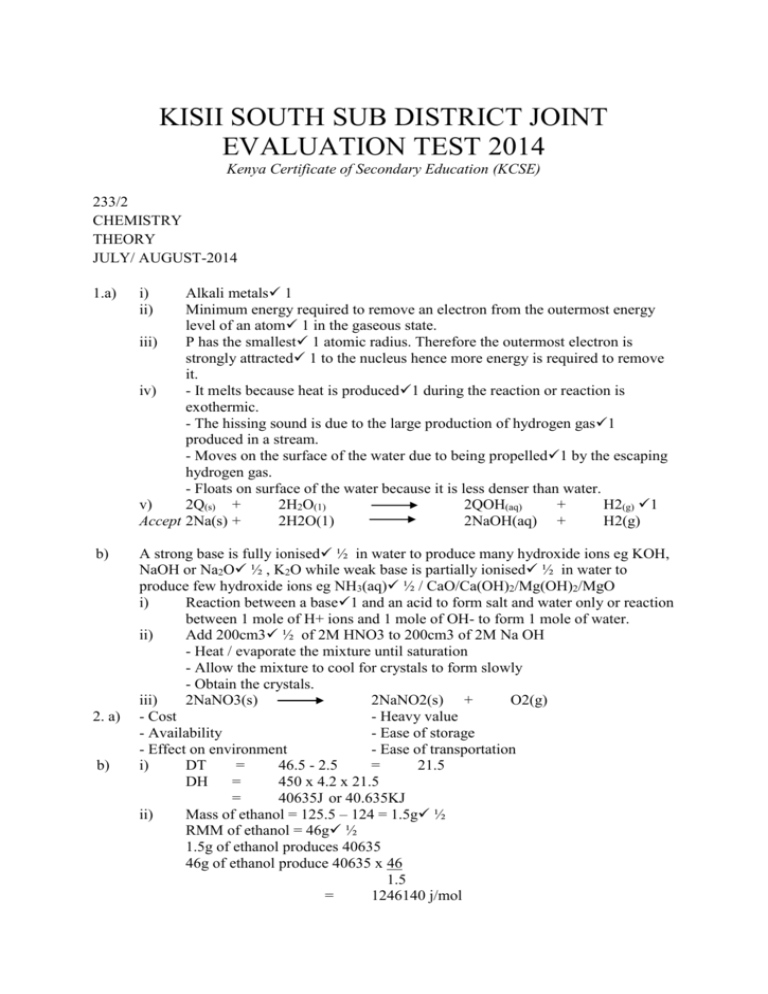
KISII SOUTH SUB DISTRICT JOINT EVALUATION TEST 2014 Kenya Certificate of Secondary Education (KCSE) 233/2 CHEMISTRY THEORY JULY/ AUGUST-2014 1.a) i) ii) b) A strong base is fully ionised ½ in water to produce many hydroxide ions eg KOH, NaOH or Na2O ½ , K2O while weak base is partially ionised ½ in water to produce few hydroxide ions eg NH3(aq) ½ / CaO/Ca(OH)2/Mg(OH)2/MgO i) Reaction between a base1 and an acid to form salt and water only or reaction between 1 mole of H+ ions and 1 mole of OH- to form 1 mole of water. ii) Add 200cm3 ½ of 2M HNO3 to 200cm3 of 2M Na OH - Heat / evaporate the mixture until saturation - Allow the mixture to cool for crystals to form slowly - Obtain the crystals. iii) 2NaNO3(s) 2NaNO2(s) + O2(g) - Cost - Heavy value - Availability - Ease of storage - Effect on environment - Ease of transportation i) DT = 46.5 - 2.5 = 21.5 DH = 450 x 4.2 x 21.5 = 40635J or 40.635KJ ii) Mass of ethanol = 125.5 – 124 = 1.5g ½ RMM of ethanol = 46g ½ 1.5g of ethanol produces 40635 46g of ethanol produce 40635 x 46 1.5 = 1246140 j/mol 2. a) b) Alkali metals 1 Minimum energy required to remove an electron from the outermost energy level of an atom 1 in the gaseous state. iii) P has the smallest 1 atomic radius. Therefore the outermost electron is strongly attracted 1 to the nucleus hence more energy is required to remove it. iv) - It melts because heat is produced1 during the reaction or reaction is exothermic. - The hissing sound is due to the large production of hydrogen gas1 produced in a stream. - Moves on the surface of the water due to being propelled1 by the escaping hydrogen gas. - Floats on surface of the water because it is less denser than water. v) 2Q(s) + 2H2O(1) 2QOH(aq) + H2(g) 1 Accept 2Na(s) + 2H2O(1) 2NaOH(aq) + H2(g) = -1246.14kj/mol C2HsOH(1) + 3O2(g) 2CO2(g) - Heat lost to surrounding air or apparatus - Error in reading temperature or mass. - Incomplete combustion of ethanol - A little of the ethanol evaporates as the burner cools. c) d) C2HsOH(1) + 3O2(g) + 3H2O(1) (Heat change) ΔHc ½ =-1246.14ks/mol Energy ½ 2CO2(g)+3H2O(1) ½ (ks) Reaction path ½ R ½ , It has the one ½ with the most negative EӨ value. 3. I. a) S2(s) EӨ = b) 2S+( aq) + 2e- c) Q(s) + Y2+(aq) d) E.m.f = E reduced = 0.34 – (-0.13) ½ = 0.47 volts. ½ 0.00v1 Y(s) - +Q2+(aq) 1 EӨ oxidised e) It has no mobile ions 1 which are required for the reaction with lead to produce electric current. II) a) d) i) Water 1 ii) Titanium 1 b) Chloride gas1 c) i) Na+(aq) ii) NaHg(l) + e- Na(s) 1 + 2H2O 2NaOH + - To minimise cost of operation. It is expensive. - To minimise its pollution effects. It is poisonous.(Any 1) 4. a) i) Alkynes1 ii) Carboxylic/ Alkanoics acid1 H2(g) + 2Hg(l) 1 b) c) i) Vulcanisation1 ii) Hardening the rubber/ to make it stronger or harder. i) 2CH3CH2CH2OH(l) + ii) I Dehydration II Hydrogenation A 1,2 – dibromo propane B Ethene[] iii) iv) d) 2K(s) 2CH3CH2CH2OK + H2(g) Nickel/ platinum/palladium - Source of fuel - Manufacture of carbon black used as a component of printers ink - Preparation/ manufacture of methanal and chloromethane which are useful industrial chemicals. (Any 2) 5. a) Is the mass of solute 1that dissolves in 100g of H2O or solvent to form a saturation at a given temperature or mass of a solute that saturates 100g of a solvent at a particular/ given temperature. b) i) -Scale1( ½ each axis) -Plotting A 1 B1 -Curves A1 B1 c) i) 24℃ ±1℃ 1 ii) Solubility at 50℃ = 37g/100g 100g 37g 35g iii) ? 35 37 = ½ 100 = 12.95g ½ From graph Solubility at 50℃ of A = 84g/ 100g ½ Solubility at 50℃ of B = 37g/ 100g 1 84 – 37 = 47 2 ± 1g (46g – 48g) d) 6. Fractional crystallisation. ½ i) Under water – It readily reacts with oxygen when exposed to air. ii) Burning phosphorous caused hot air to expand and increase pressure to push down the water. After cooling the volume of air used for combustion of phosphorous was filled by water rising up the bell Jar. iii) The white fumes of the phosphorous (v) oxide or Phosphorous (iii) Oxide dissolved in the water to form a colourless. iv) 80 64 100% 20% 80 v) P4(s) + 5O2(g) 2P2O3(s) P4 + 3O2(g) 2P2Q3(s) 4P(s) + 5O2(g) 2P2O5(s) vi) Red litmus paper remained red/ unchanged Blue litmus paper turned to red P2Qs dissolved in water to form phosphoric acid b) 7. a) i) Fe2O3.XH2O ii) Cuts off supply Oxygen iii) They have a sacrificial metal on them. A – Carbon(iv)Oxide B - Ammonia b) C – Ammonium chloride D – Sodium hydrogen carbonate c) P →NH3(g) + NaCl(aq) + CO2(g)H2O(l) R →2NH4 Cl(aq) + Ca(OH) d) Calcium chloride – NaHCO3(s) + NHCO3(s) + NH4Cl(aq) CaCl2(aq) + 2NH3((g) + 2H2O(l) used as a drying agent Used to lower the melting point of molten NaCl in the extraction of sodium e) Ca2+ (aq) + CO32-(aq) CaCO3(s) Mg2+ (aq) + CO32-(aq) MgCO3(s) Ca2+ and Mg2+ causing the hardness are precipitated as insoluble carbonates.
